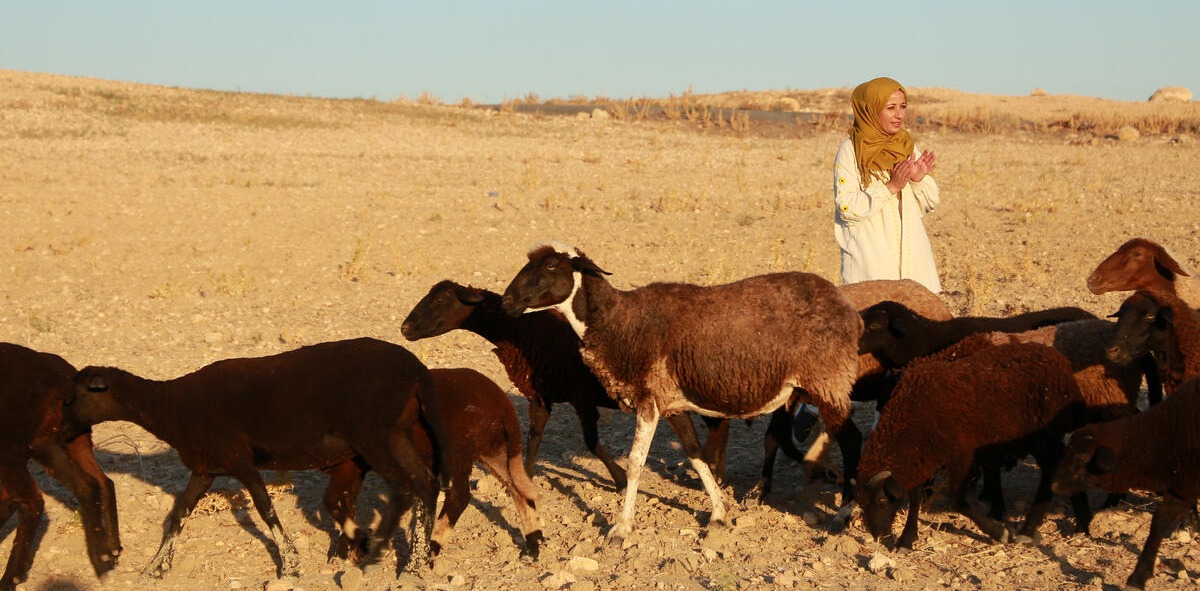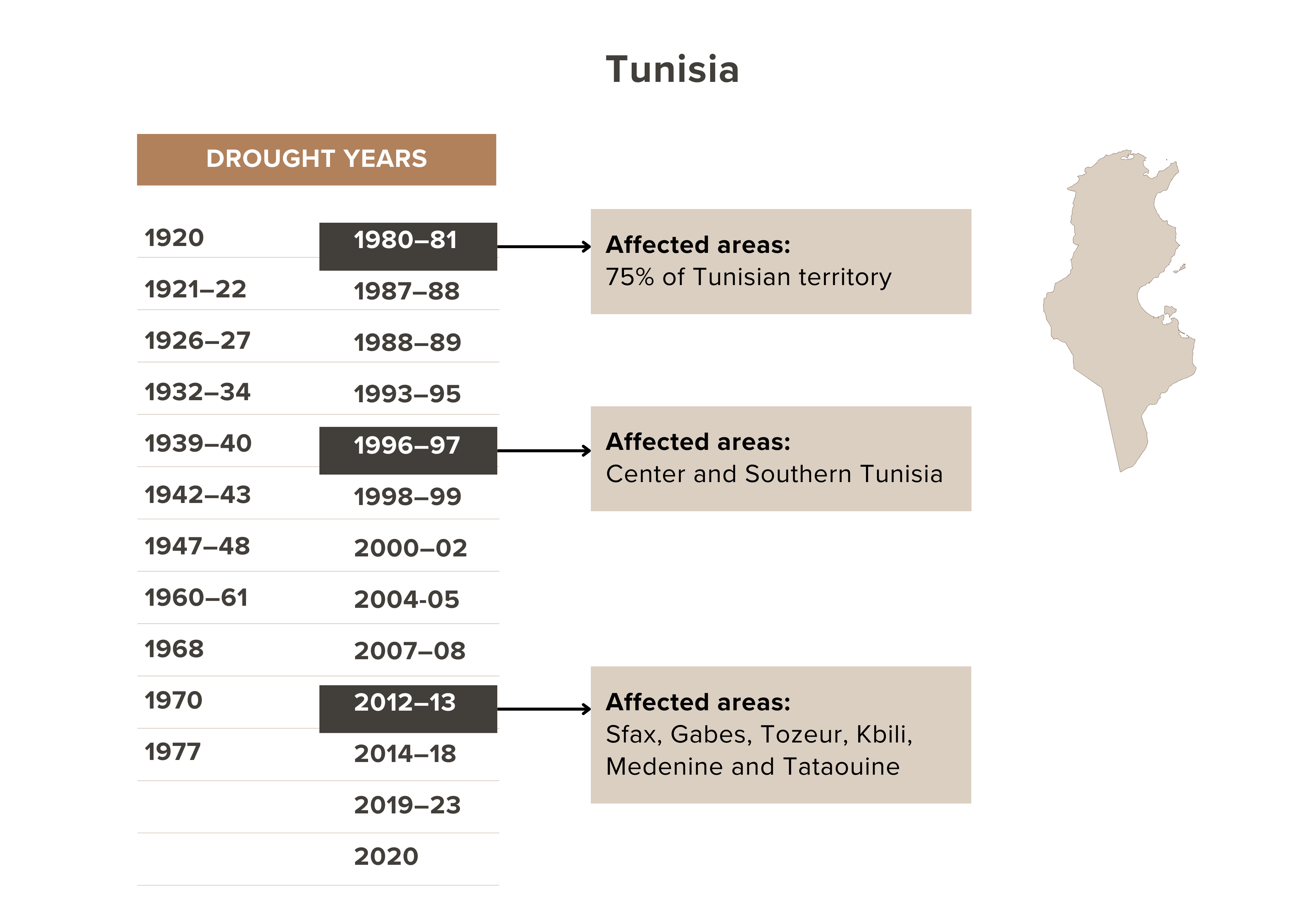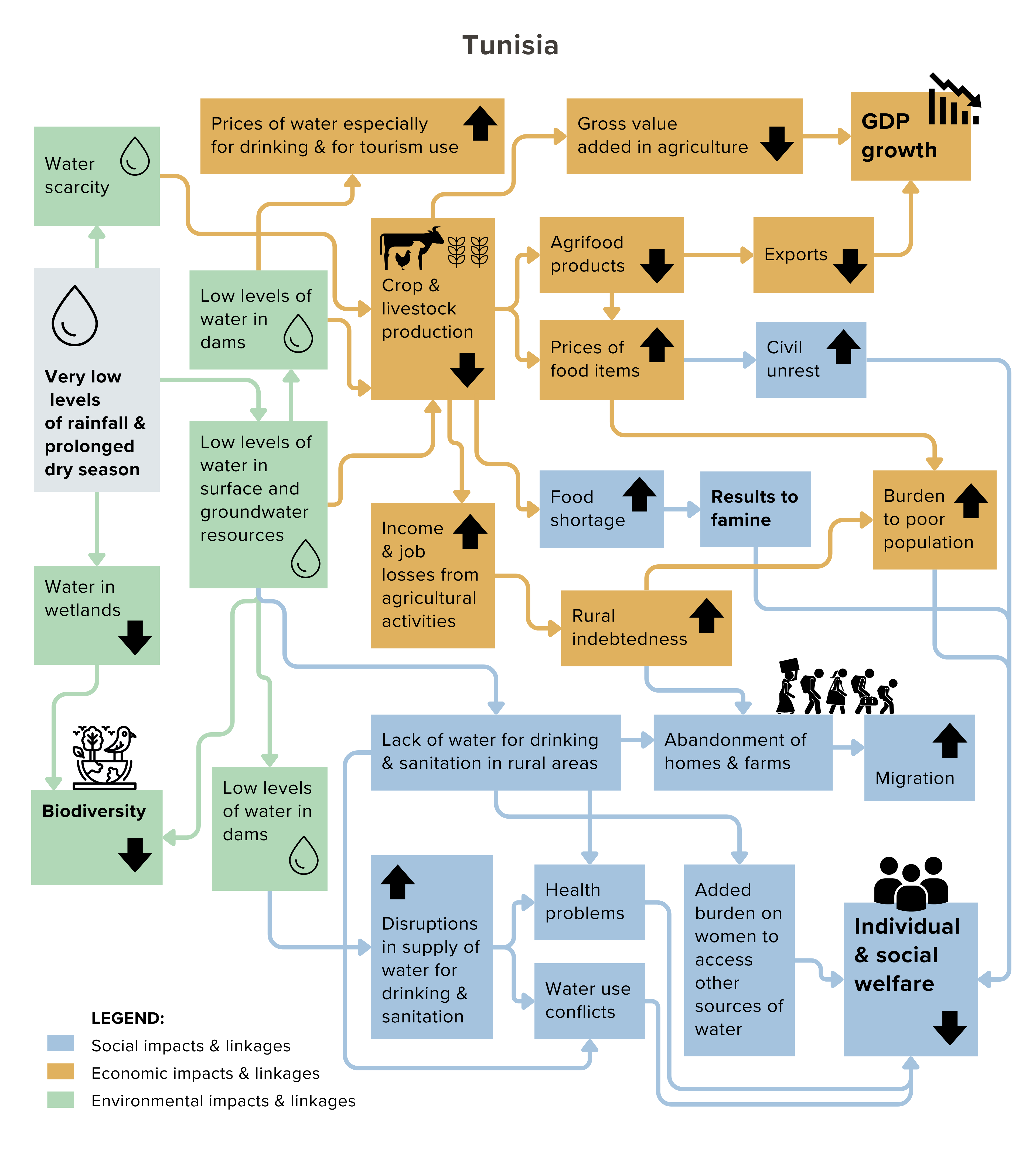
Tunisia
HISTORICAL DROUGHT – Tunisia is located in northern Africa, with Algeria in the west, Libya in the southeast, and the Mediterranean Sea in the northeast. Recurrent long droughts are experienced in the country, often lasting more than a year. Notable droughts in Tunisia include the 1960–1961 drought event, wherein 75% of the stations recorded a negative standardized precipitation index (SPI) during these years. More than 15% of stations registered the event as a severe drought, and more than 25% of stations recorded it as an intense drought. In 1980–1981, severe droughts (reconnaissance drought index [RDI] < −1.5) were reported in 12 stations, and dry conditions covered 75% of the country. Meanwhile, the 1993–1994 drought registered 27.7 billion m3 of rainfall, way below the annual average of 36 billion m3.

DROUGHT IMPACT PATHWAY – Droughts have significant impacts on the economy of Tunisia, particularly in agriculture, exports (especially on exported agrifood products such as olive oil), and services sectors (tourism and water utility). Severe and prolonged drought events also have dangerous impacts on the welfare of the population in terms of food availability, health, and sanitation conditions, among others. Under extreme conditions, like during the drought of 1920, famine was experienced in Tunisia. In rural areas, women have the added burden of accessing alternative water sources. Drought also impacts Tunisia’s ecosystems and threatens biodiversity in the country.

Highlights of drought vulnerability dimensions
- 12.36 million population, with 29.8% living in rural areas (2022).
- 16.6% poverty rate (2021).
- 12.6% food insecurity (2021).
- 77.9% female literacy rate, compared to 89.5% male literacy rate (2022).
- women and girls aged 15+ spend 21.9% of their time on unpaid care and domestic work, compared to 2.7% spent by men (2018).
- 10.1% of women aged 15-49 years reported that they had been subject to physical and/or sexual violence by a current or former intimate partner in the previous 12 months (2018).
- 78.1%, of children in employment, unpaid family workers (% of children in employment, ages 7-14) (2012).
- Agriculture comprises 9.8% of GDP and 14.0% of total employment (2022).
- Cereal, olive, and livestock farming on rangelands are key agricultural activities in Tunisia.
- Northern region produces 85% of Tunisia’s cereal production.
- Tunisia is among the world's major producers and exporters of olive oil.
- More than 65% of olive-growing areas are in the central region of Tunisia, more than 18% in the south, and less than 17% in the north.
- Governorates of Sfax, Sidi Bouzid, and Kairouan produce 20%, 13%, and 10% of olive production.
- Irrigated fruit trees are mainly olives (41%) and date palms (18%).
- Livestock contributes around 35%–40% to agricultural output.
- Cattle breeding is practiced in northwest areas, and goat breeding in the south and center. Kébili, Tataouine, Kairouan, Kasserine, and Sidi Bouzid have high livestock farming activities.
- 77% of water is allocated to agricultural activities, 13% for drinking, 8% for industrial purposes and 2% for tourism.
- 26.3% unemployment among women, compared to 14.2% among men (2022).
- 8.8% of employed women are in agriculture, compared to 15.8% of employed men (2022).
- 26.9% female labor force participation rate, compared to 69.0% male labor force participation rate (2023).
- 3.9% of total agricultural land is irrigated (2013); agricultural lands are chiefly rainfed.
- Total surface equipped for irrigation is 443 000 ha (2020).
- 49% of the irrigated lands use localized irrigation systems and 28% use sprinkler systems.
- 97.4% of the total population and 97.1% of the rural population use at least basic sanitation services (2022).
- 74.3% of the total population and 67.1% of the rural population use safely managed drinking water services (2022).
- 125 sanitation stations and 193 of 350 municipalities with the facilities (2021).
- The volume of wastewater treated in sanitation stations totals 288.5 million m³ (2021).
- Quality of water from treatment stations does not meet national standards and is unsuitable for industrial and agricultural purposes.
- Tunisia has 37 dams, 258 small hilly dams, and 913 hilly lakes with a total storage capacity of 2708 million m³.
- Tunisia's big dams include Sidi Salem dam (555 million m3 capacity), Sidi El Barrack dam (275 million m3 capacity), and Sidi Sââd dam (209 million m3 capacity).
- Poor conditions of water infrastructure – more than 700 million m³ are lost annually from leaky irrigation pipes, and 120 million m³ are lost yearly from outdated drinking water networks.
- Experiences increased dam water salinity due to the accumulating hard residues in dams.
- Has deteriorated water quality due to outdated water infrastructure networks.
- 62.4% of land area is agricultural land (2021).
- 58.7% agricultural water withdrawal as % of total renewable water resources (2020).
- 80% of surface water is in the northern region, and only 5% is in the South.
- Rainfall varies geographically, with around 600 mm in the north, 300 mm in the center, 150 mm in the south, and less than 100 mm in the extreme southwest
- Annual evapotranspiration is about 1200 mm in the north and more than 180.0 mm in the south.
- 44.5% of Tunisia’s water potential comprises groundwater; the country has 226 shallow water tables and 340 deep aquifers.
- Tunisia consistently exhibited high water stress: 94.6% (2016), 96.0% (2018), 96.3% (2019), 98.1% (2020).
- There is intensive exploitation of underground resources.
- There is a downward trend in the piezometric level of the Sisseb-El Alem aquifer in Kairouan, signifying a high level of overexploitation.
- It has 231 wetlands covering 1 250 200 ha.
- Tunisia developed the National Drought Management Plan in 2020 to improve drought risk management.
- Plans & frameworks related to drought risk management, disaster risk reduction, climate change: National Strategy for Adapting Tunisian Agriculture and Ecosystems to Climate Change (2007), National Strategy for Adaptation to Climate Change (2012), National Sustainable Development Strategy (2014), 2023–2025 Development Plan, 2030 National Strategy on Disaster Risk Management (2021) and its Action Plan.
- Government agencies relevant to drought risk management: National Council for the Fight against Desertification, National Water Council, National Commission for Sustainable Development, National Commission for Natural Disasters, Technical Monitoring and Alert Committee, Ministry of Agriculture, Water Resources and Fisheries..
- Institutional laws and regulations related to water, drought risk management, disaster risk reduction, climate change: Constitution of Tunisia (2014), Water Code (31 Mar 1975), Law 30/2000 on the development of agricultural land within the public irrigated perimeters (PPI), National Water Council Decree No. 407/2010 of 9 March 2010.
- Financial funds to assist recovery from drought impacts are institutionalized in Tunisia, specifically the National Guarantee Fund and Fund for Compensation for Agricultural Damage Caused by Natural Disasters.
- In 2023, a Decision issued by the Ministry of Agriculture imposed water rationing and water use restrictions in Tunisia.
Abdelmalek, M.B & Nouiri, I. 2020. Study of trends and mapping of drought events in Tunisia and their impacts on agricultural production. Science of the Total Environment, 734:1–17.
FAO. 2021. In: AQUASTAT - FAO's Global Information System on Water and Agriculture. Rome, FAO. [Cited 23 April 2024]. https://www.fao.org/aquastat/en/databases/dams/
FAO. 2024. In: Water efficiency, productivity and sustainability in the NENA regions (WEPS-NENA). Rome, FAO. [Cited 24 April 2024]. https://www.fao.org/in-action/water-efficiency-nena/countries/tunisia/en/#:~:text=Most%20of%20the%20exploitable%20renewable,used%20by%20agriculture%20for%20irrigation.
Mohamed, M.A.E, Moursy, F.I., Darrag, M.H., & El-Mahdy, M.E. 2023. Assessment of long-term trends and mapping of drought events in Tunisia. Scientific African, 21:e01766
Ministry of Agriculture & Ministry of Environment. 2020. National Drought Management Plan – Tunisia. [Cited 22 April 2024]. https://www.unccd.int/country-profile-document/tunisia
Rhili, H. 2023. The World Bank’s Water and Sanitation Policies in Tunisia. In: Transnational Institute. Amsterdam, Netherlands, TNI. [Cited 23 April 2024]. https://www.tni.org/en/article/the-world-banks-water-and-sanitation-policies-in-tunisia
UN Women. 2024. Tunisia. In: UN Women. New York, USA, UN. [Cited 23 April 2024]. https://data.unwomen.org/country/tunisia
World Bank. 2024. In: World Bank Open Data. [Cited 9 April 2024]. https://data.worldbank.org/
FOCUS on Vulnerability
Economic sectors: Agriculture and livestock, water utility, agrifood exports
Social groups: Rural population, agricultural households and communities, people employed in agriculture, women population, children, cereal/olive growers, livestock farmers, poor population
Geographical areas: North, northwest, southern and central regions, Sfax, Sidi Bouzid, Kairouan, Kébili, Tataouine, Kasserine, Sidi Bouzid
